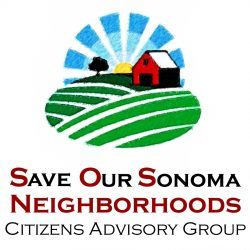Close to Home: Sonoma County can do more to protect rural residents from fires (Press Democrat)
In November, the world watched with horror as residents of Paradise tried to escape from an oncoming wildfire on clogged roads, some so desperate that they abandoned their vehicles and fled on foot. Two weeks ago, columnist Pete Golis asked whether government can reduce the risk from wildfires. The answer to his timely question is yes.
Here’s how: Our county government should enforce the state’s fire-safe road regulations to stop new development in fire-prone areas and better enable emergency access and evacuation.
These regulations establish minimum standards for developments in so-called State Responsibility Areas — including most of unincorporated Sonoma County — that are accessed by long, narrow and often dead-end roads.
The standards include minimum 20-foot road widths, periodic turnouts, no one-lane roads unless they’re less than a half-mile and connect with a two-lane road at both ends, and dead-end roads are allowed only if they’re 20 feet wide and no more than a mile long.
Thirty years ago, in an instance of prescience, the state Legislature became concerned about development in fire-prone locations. It directed Cal Fire to issue regulations to require fire-safe roads for development. It did so in 1991.
The county has chosen to exempt roads built before 1992 from the state regulations. This decision excludes most of rural Sonoma County from protection. Yet a 1993 California attorney general opinion says that state law pertains to all roads, not just those built after 1992.
Sonoma County’s approach is contrary to other California counties. Napa County applies fire-safe regulations to all roads. In San Diego County, it’s difficult to get a building or business permit for properties without two ways out. Our lawyer, Kevin Block, has informed the county that any permits issued in violation of the standards are invalid.
Our interest began with the location of commercial cannabis cultivation in unsuitable rural areas. But the regulations govern all new development in State Responsibility Areas, including new homes and wineries (but not rebuilding homes after the fires). We didn’t discover these regulations until cannabis program managers, eager to promote the industry and hungry for revenue, slammed door after door in our faces. They refused to allow us to establish exclusion zones, even in fire-prone areas, failed to stop projects that don’t meet the ordinance’s criteria and promoted projects that don’t meet zoning requirements or land-use policies.
The county has allowed inappropriate cultivation projects for two years under its amnesty (“penalty relief”) program on roads that don’t even approach meeting the state regulations. Among them are Cougar Lane, Los Alamos Road, Palmer Creek Road, Matanzas Creek Lane and Bunnell (Grange) Road. All are dead-end roads over a mile long that are very narrow, some under 12 feet wide. The October 2017 fires burned through many of these areas and destroyed homes. This isn’t a theoretical issue. In many of these locations, the county is prepared to allow a third growing season without permits being issued.
PG&E is expected to file bankruptcy because it may be liable for damages caused by large destructive fires. But some of the blame lies with a county government that allows development in remote areas with inadequate roads. PG&E is obligated to service those areas once the county allows development, but should the county allow development there at all?
Last month, retiring Cal Fire Chief Ken Pilmot suggested that California consider going beyond the current fire-safe regulations and banning new home construction in areas prone to fires. Even if the county continues to disagree with the state regulations and excludes pre-1992 roads from regulation, does issuing cannabis and other permits on unsafe roads make any sense? What can county leaders be thinking?
https://www.pressdemocrat.com/opinion/9208807-181/close-to-home-sonoma-county?sba=AAS&artslide=0
Deborah A. Eppstein is a scientist and retired biotech entrepreneur who lives on Cougar Lane. Craig S. Harrison is a retired lawyer who lives in Bennett Valley.
